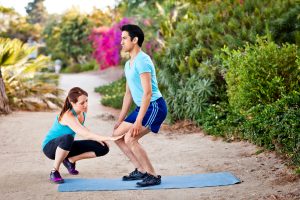Personal trainers may have questions on how to direct their clients with optimal squat foot position, and with good cause: the kinetic chain starts at the feet. Squat with your feet bare and in a variety of positions to maximize the benefits of lower-body workouts. Foot (and ankle) position when performing a squat affects the muscles recruited all the way up the chain of movement. Every joint is connected!

Starting with knees over the toes is a good general rule of thumb when you are first teaching a squat to clients. Cueing clients in this position can create a strong foundation and build body awareness. Being aware of one’s body in space can prevent injuries and enhance results.
Squat Foot Positioning and Beyond
Position feet in a variety of directions when training people on squats so that the muscles up the chain of motion that react to various foot positions all get a chance to work.
- Use narrow stance, wide stance, and plie when squatting.
- Change the angle of the position in a plie squat.
- Place one foot slightly more forward than the other – not quite a lunge – just a staggered squat.
Realize there is a lot more to squatting than “knees over toes”, feet wide, and feet narrow. Your foot has 33 joints and what happens at your feet doesn’t stay at your feet. The motion or lack of motion in your feet moves up the chain of motion.
To understand the mechanics of foot position let’s look at these two scenarios.
Foot and ankle eversion (feet flatten) causes:
- internal rotation of the tibia (when flexed) and hip
- hip adduction (knee valgus)
- flexion of the knees, hips, and spine
- the upper body into a rounded position with the scapula protracting
Foot and ankle inversion causes:
- external rotation of the tibia (when flexed) and hip
- hip abduction (knee varus)
- extension of the knees, hips, and spine
- the upper body into an erect position with the scapula retracting
When squatting, feet naturally invert and evert at different parts of the motion. Take off your shoes and observe your feet while you slowly squat. Feet need to be able to both invert and evert. If feet are weaker in one or the other it will affect everything else that happens in the body during movement. If you have rigid arch supports in your shoes it will affect the entire chain of motion because your feet cannot evert as fully.
If you aren’t clear on what I mean, take off your shoes – I’ll show you.
- Rotate your body right and left. Notice how one foot inverts while the other everts.
- Try forcing inversion of both feet, the way arch supports do and rotate.
- Then try forcing eversion of both feet, the way a weak arch does and rotate.
- You will notice rotation is limited by lack of symmetry between inversion and eversion.
Barefoot Squatting
Do you ever have clients squat while barefoot? Having your clients’ shoes off when squatting allows you to fully evaluate what is happening in the body. When shoes are on there are 33 joints that cannot be seen.
These 33 joints in the foot affect posture, position, and performance.
Shoes protect our feet. Shoes also limit and handicap our feet. Shoes aren’t bad, they just have an impact on the outcome of the exercise. Stacey Lei Krauss, a barefoot running coach says, “You wouldn’t wear shoes on your hands because of how much they would limit your ability. Having shoes on your feet when squatting isn’t any different.”
Of course, shoes are valuable when lifting heavy weight and when walking around on concrete. But, I encourage you to train clients on proper squatting position with their shoes off on a solid and safe surface.
Build solid foundations, stronger feet, and squat with more efficiency.
Train the muscles in your client’s feet and ankles the way you do the other muscles in the body. There are 11 muscles in each foot that need just as much attention as shoulder muscles or abs. Doing proper assessments and following with strengthening exercises will help ensure your clients’ squat foot position is serving them well.
[sc name=”functional” ][/sc]
Beverly Hosford, MA teaches anatomy and body awareness using a skeleton named Andy, balloons, play-doh, ribbons, guided visualizations, and corrective exercises. She is an instructor, author, and a business coach for fitness professionals. Learn how to help your clients sleep better with in Bev's NFPT Sleep Coach Program and dive deeper into anatomy in her NFPT Fundamentals of Anatomy Course.

